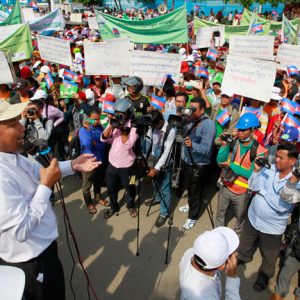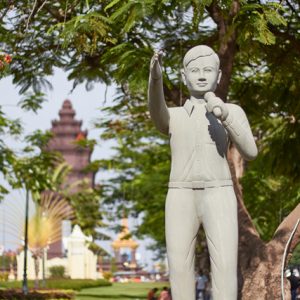After five garment workers were shot dead by Cambodian security forces in Phnom Penh last January during a ten-day nationwide strike, the general secretary of the Garment Manufacturers Association in Cambodia (GMAC), Ken Loo, described the deaths as “collateral damage”.
Almost two years on, Loo says he “100%” sticks by this comment. “If they were innocent bystanders, then it’s collateral,” he told Southeast Asia Globe. “But if they weren’t and they were participating in violence, then they were perpetrators… the authorities had to respond.”
Sat in a spacious meeting room in GMAC’s Phnom Penh headquarters, Loo explained that last January’s strikes are emblematic of what he calls a “militant” trade union movement. “It’s lawless,” he said. “Every single strike in Cambodia, from the beginning of time, has not complied with the procedures set up under the law, which effectively means they’ve all been illegal.”
He added that this has only worsened because of the Cambodian government’s limp response – the unions now believe they can “get away with violence”, and the government will do nothing.
The picture Loo paints is one of uncontrollable unions, interested only in conflict, given a free reign by a fearful government. The victims, for Loo, are the employers, forced into paying a higher minimum wage – increased from $100 to $128 in December – and powerless to prevent collective bargaining.

Ath Thorn paints a different picture. He is the president of the Cambodia Labour Confederation (CLC), the largest confederation of independent unions, and one of the main proponents of another raise in the minimum wage. Final negotiations between the government, employers and unions are taking place this month. He said that ruthless employers regularly “cheat and violate” the innocent workers, and that the government has stepped up its efforts to arrest union leaders and almost always takes the side of employers in disputes.
This difference in opinion is not surprising: labour and capital have been battling it out across the world for centuries. However, despite Loo’s melancholic view, there are suggestions that the trade union movement is being brought to its knees.
Tola Moeun is the head of the labour programme at the Community Legal Education Centre, an independent legal resource centre in Cambodia. He says he is “very worried” about the state of trade unions today and believes the problem stems from two issues: legislative attacks from outside the movement and weaknesses from within.
“There are too many unions that are controlled by the ruling party, and they are trying to split the movement,” Moeun said. In recent years, he added, the number of unions controlled by the ruling Cambodian People’s Party (CPP) have increased, and there is now only one independent union association that is “struggling by itself” to keep the movement free from political control.
This independent association is Thorn’s CLC. During Southeast Asia Globe’s interview, Thorn was careful not to criticise other unions, even those aligned with the government. William Conklin, country director of the Solidarity Centre, an international workers’ advocacy NGO, was not as reticent.
“It’s very hard to build united union action in Cambodia,” he said. “If in a workspace you have six unions, there’s competition to get the workers [as members] and become the main bargaining agent. Employers are very much part of the problem; if they don’t like a union they will try to form another one that’s less hostile. Then you have the CPP-aligned unions, which aren’t really unions.”
Conklin rummaged through his files and found a chart his organisation had produced, mapping each of the larger unions in Cambodia – it did not include the smaller ones, as there are said to be an average of seven unions in each of the country’s 600 or so garment factories. On the chart were the six unions and one confederation aligned with Cambodia’s largest opposition party, the Cambodia National Rescue Party (CNRP), ten independent unions under the CLC and more than 70 unions and nine confederations aligned with the ruling CPP.
“The government has another structure too, called the Labour Advisory Council (LAC). It’s used as a vehicle for the government to say: ‘We’ve consulted with unions,’” Conklin said. The LAC is comprised of 28 representatives: 14 from government, seven from employers and seven from unions. “But five of the seven unions are CPP-aligned ones. So, for example, during minimum wage negotiations, the decision will be whatever the government wants – because the CPP unions will support it – and it’s probably going to side with the employers too,” Conklin added.

According to Markus Karbaum, an independent consultant specialising in Cambodian politics, it would be highly desirable for all trade unions to unite. “[As well as workers], manufacturers and the state would benefit directly because such a constellation promises predictability and stability. However, as long as GMAC and the government don’t understand that it is a big advantage to have just one union in the garment industry, I do not expect any change.”
For Thorn, one single trade union would be desirable as long as it is independent. However, a controversial trade union law that has been in draft form for at least five years, and looks increasingly likely to be ratified, would shift the goalposts considerably.
The draft law was leaked in 2010 and since then it has gone through numerous incarnations. Conklin claimed that in 2014 the draft law suddenly reappeared, following years of obscurity, in “very anti-union form and has gotten worse since then. Some say there’s the hand of GMAC in this, in either writing it or influencing the government. The aim is really to target both union leaders and the ability of the unions to strike.” However, he added, the government will say the draft law is “to safeguard and help unions”, and the employers say it is to “cut down on the multiplicity and amount of unions”.
Thorn agrees. He and the independent unions have been fighting against the draft law for years.
“The whole process has not been open,” Thorn said. “They have not taken on our comments and have put more [clauses] that are damaging. It says if workers want to establish a union, they must have at least 20% of the workers supporting them at their company. If not, they cannot create.”
However, a few weeks after Southeast Asia Globe spoke to Thorn, a number of provisions were changed in the draft law. A previous clause that said 20% of workers in a factory have to join a union for it to be created was dropped to 10%. Also, unions will not have to apply for a licence to operate, and union leaders will not have to provide letters about their criminal records, as were previously stipulated.
After this news, Thorn told the Phnom Penh Post that he was still not happy. “Frankly, I do not want this law to be passed,” he said. “Although some points that we were concerned about were removed, it still has some that we do not like, such as trade unions having to report their finances to the ministry every year, and 25% of members being able to dissolve their own union, and some others.”
In the same Phnom Penh Post article, Som Aun, president of one of the largest CPP-aligned unions, the Cambodian Council of National Unions, expressed his support for the changes and said he would now accept the law as it is.
“How do you build up a unified front in all of this?” Conklin asked. “The CLC is taking the lead [in opposing the draft law], but then there are some who have broken away and don’t appreciate them taking the lead. The government unions are just going to say ‘OK’ and maybe provide a few comments, but they’re fine with it.”
Whether or not these divisions have severely damaged the movement will maybe become apparent in the coming months. Tensions could flare up if negotiations over another rise in the minimum wage of garment workers, which will conclude this month, do not come to a satisfactory conclusion for the unions.
Loo, speaking on behalf of the garment employers, said that another raise would be disastrous. “If it does go up, then some factories will have to close,” he said. “They just can’t operate at these levels.” These fears are, perhaps, now even more intense due to the fact that, in August, Myanmar – a country widely seen as the next frontier for garment manufacturing in Southeast Asia – set a minimum wage of $2.80 per day, roughly $67 per month, to boost investment in the industry. In August, GMAC released a survey of garment employers in Cambodia that showed 63% do not want a raise at all and only 26% would support a raise of between $1 and $5 per month.
Thorn, however, came out in mid-September to announce that he and the independent unions would not be pushing for $177 per month, as expected, but for $207. This figure is based on an independent study by the local research firm, DC Research, that found $207 to be the median amount of money spent per month by surveyed garment workers.
Speaking in July, Thorn told Southeast Asia Globe he was “optimistic” about clinching a wage increase but added that “it will not be easy”. He was also optimistic about the future of Cambodian trade unionism.
“From the beginning, the employers tried to cut us down,” Thorn said. “They use any tactic to persuade the workers to join pro-government unions. But more and more workers now understand independent unions are better. More and more workers believe in trade unions.”


